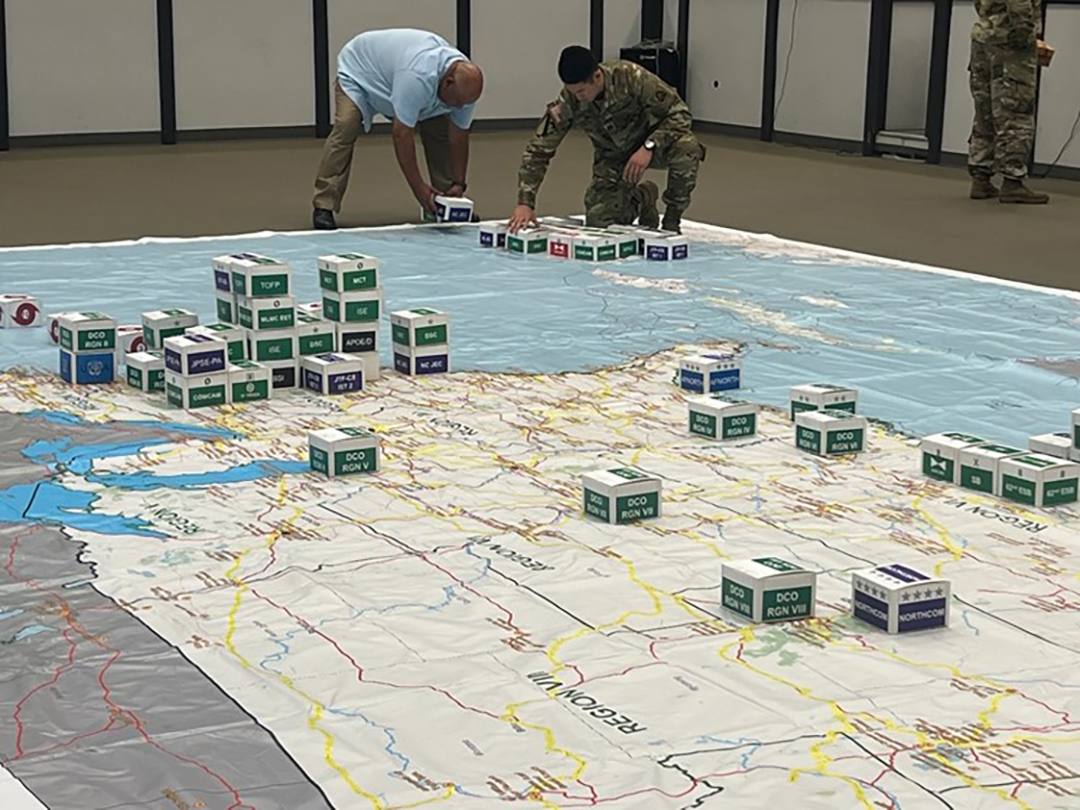U.S. Army Lt. Gen. John R. Evans, U.S. Army North commander, hosts personnel from federal, state, U.S. territories and military agencies at the hurricane-readiness drill held at Joint Base San Antonio–Fort Sam Houston. U.S. ARMY
THE WATCH STAFF
U.S. Northern Command (USNORTHCOM) and U.S. Army North (USARNORTH) recently joined more than 150 military and civilian partners at Joint Base San Antonio-Fort Sam Houston as part of a defense support to civil authorities readiness drill ahead of hurricane season, which started June 1 and ends November 30.
The May 24 exercise, called a hurricane rehearsal of concept drill (HRCD), focused on seamless integration and sharpening coordination among local, state and federal agencies in the event of a hurricane.
“Each of us here today has a significant role to play when disaster strikes in our backyards,”
Lt. Gen. John R. Evans Jr., U.S. Army North commander, told the participants. “We assemble like this each year, not only to bring together our capabilities and experience during natural disasters, but so that the day of execution isn’t our first time working together.”
USARNORTH is the land component of USNORTHCOM and the Army’s dedicated headquarters focused on the U.S. Department of Defense’s (DOD) operations within the homeland. The drill represented a departure from previous exercises, with participants imagining a scenario involving three hurricanes striking the coastal Atlantic and Gulf of Mexico regions sequentially, USARNORTH said.
Evans asked participants to embrace the challenge. “We all hope disaster never strikes, but it’s our job to train for the worst possible scenarios to ensure we’re ready to answer the call to serve the American people when they need us most,” he said during opening remarks.
To prepare for hurricane season, the DOD works each year with local, state and federal authorities to develop whole-of-government response efforts, which typically come at the request of a federal agency and with approval of the secretary of defense.

“Coming together for this rehearsal helps identify gaps and seams in our plans and coordination,” said FEMA Region 6 Administrator Tony Robinson, whose area includes Arkansas, Louisiana, New Mexico, Oklahoma and Texas. “In addition to the whole community effort of local, state and federal partners, we encourage residents in the risk areas to look at their preparedness plans.”
The annual drill enables U.S. Army North, joint military services, federal agencies and other participants to synchronize their communication, staffing and logistical efforts.
“We begin hurricane season planning a year out because of the unique challenges we face, and the [rehearsal of concept] drill is an important opportunity for us to synchronize our local efforts with federal and Department of Defense partners,” said U.S. Army National Guard Maj. Gen. Kodjo Knox-Limbacker, the adjutant general of the Virgin Islands National Guard.
Since 2005, U.S. Army North, USNORTHCOM’s joint-force land component command, has responded to more than 40 tropical storms and hurricanes.
Last year, there were 14 named storms, of which two – Hurricane Ian and Hurricane Fiona – intensified into major hurricanes reaching wind speeds of 111 mph or greater. According to the National Oceanic and Atmospheric Administration (NOAA), 156 people lost their lives during Hurricane Ian, the third-costliest storm in U.S. history with $114 billion in damages.
NOAA released a midseason hurricane update on August 10, raising the forecast from 14 to 21 named storms, of which six to 11 will become hurricanes and two to five will reach major hurricane strength, according to the Tampa Bay Times newspaper.
Of the many roles of the National Guard, one is to assist communities striving to cope with natural disasters. “We live and work in these communities,” Brig. Gen. Jonathan Beddall, vice director of the National Guard Bureau’s Joint Operations Center, said during a May 23 media roundtable. “So, we’re invested in every response in order to make ourselves a little bit better, so that we can meet the needs that need to be met.”
USNORTHCOM, USARNORTH and interagency partners routinely execute domestic-relief operations in support of a lead federal agency such as FEMA, which allow the U.S. to recover quickly from natural disasters. These efforts demonstrate national resilience, reassure the public and show potential adversaries that the U.S. homeland can recover quickly.


Comments are closed.